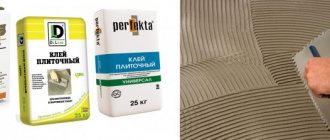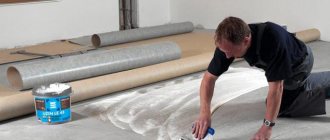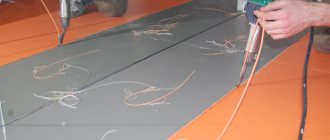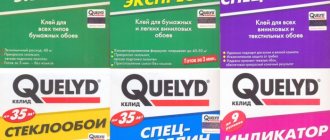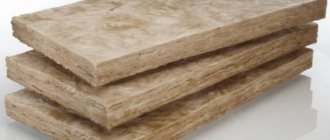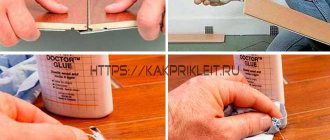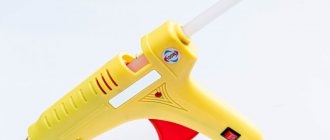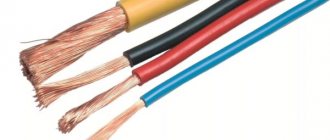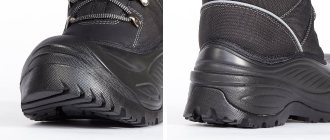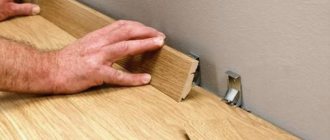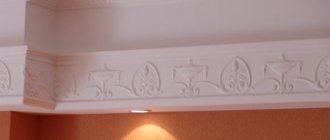White PVA glue
This is the most common adhesive for porous lightweight materials such as paper, cardboard, fabric, leather, foam.
PVA glue on 85-95%
consists of polyvinyl acetate, contains up to 10% water and about 5% improving additives. Essentially, it is a water emulsion of polyvinyl acetate. Since the adhesive is water-based, it is easy to clean and has low toxicity. Keep in mind that it needs to dry before the strength becomes significant. The project often requires a clamp to hold the glued pieces in place until the glue has fully cured and dried. PVA craft glue should not be used where waterproof or waterproof properties are required.
PVA craft glue produces a transparent and flexible seam. Get creative and add fillers such as fine glitter, pigments or water-based food coloring for decorative effects.
Setting time ~ 1 hour
, final curing -
after 24 hours
.
Tips for use
To ensure that the work looks neat and the elements are securely fastened, you should adhere to the following recommendations:
- To connect natural materials, they must first be prepared. Be sure to thoroughly clean the surface to prevent mold or fungal growth from developing in the future. For example, to glue cones together, bark or branches need to be soaked in a solution of potassium permanganate or soda for 10–15 minutes.
After this, let the liquid drain and dry for 2-3 hours. Prepare a vinegar solution. Mix half a glass of water and 1 tsp. vinegar 9%. Treat materials with a spray bottle. Allow to dry completely for 2-3 days.
Wood glue
Yellow wood glue is also water-based. Consists of the same vinyl acetate polymers as PVA. It is designed for use on wood and is immediately viscous to better hold in its uncured state. It is generally harder and easier to sand. Wood glue can be white or clear, be sure to read the labels. Again, you can add glitter, sawdust, or other powdered filler for special effects.
Wood glue sets in less than 1 hour. However, it may take up to 24 hours to reach full strength.
There are three types of wood glue available that are suitable for crafts:
- Type I has some waterproof properties
- Type II will perform better in outdoor conditions. These adhesives typically have a longer open time and can bond at lower temperatures. Both types I and II can be used for outdoor applications such as garden furniture and decoration
- Type III is not waterproof and is intended for indoor use only. Type III is good for interior woodwork and trim.
Note: Special waterproof adhesive is required for stability when submerged in water.
Application technology and rules
To obtain a durable layer of silicone adhesive, the composition should be applied to well-prepared surfaces.
The products to be glued must be clean, smooth and dry. If necessary, use degreasers.
Silicones are supplied in sealed tubes with an elongated spout - it is convenient to squeeze out small portions of glue through such a dispenser.
Technology and rules for applying silicone sealant:
- Preparation of parts to be glued - clean from dust and debris, degrease, slightly widen the seams for better filling.
- You can stick masking tape along the length of the seams so as not to stain adjacent areas, for example, tiles, with glue.
- Cut off the glue spout at an acute angle. To perform a large amount of work you need a construction gun.
- Apply glue to one of the surfaces in a layer of up to 20 mm, press the second part to be glued to it and fix it.
- Immediately remove any remaining silicone glue with a rubber spatula or sponge. The mixture dries completely within 24 hours.
If you have to work with decorative elements, silicone is selected to match the color of the product.
After the glue has completely dried, peel off the masking tape. After this, the glued elements can be used.
Attention! When the silicone composition dries, do not allow the adhesive to be exposed to mechanical loads, temperature and moisture.
On video: Which silicone glue to choose?
Superglue (also known as cyanoacrylate)
Cyanoacrylate adhesives
bind very quickly to various bases. They form a very strong bond and are transparent when dry. The surfaces to be joined must be in good contact with each other to ensure proper adhesion. You can buy superglue in different viscosities, which gives you some flexibility when filling gaps. However, superglues can be finicky regarding contact with the surfaces being glued. Applying too much or too little adhesive may affect the bond. For the most part, superglues are not suitable for foam unless otherwise stated on the packaging.
Cyanoacrylates perform best in tensile applications requiring low toughness. In an uncured state, a cloth with acetone solvent can be used for cleaning. However, once cured, solvents can no longer remove the adhesive.
Cyanoacrylates are particularly suitable for paper, leather, fabric, wood and many other materials. They can harden from a few seconds to minutes, depending on the composition. When dry, they give a transparent and waterproof seam.
Conclusion: Cyanoacrylates are good for projects involving wood, metal, ceramics, leather, glass and some plastics where the bond line is very tight.
TOP-best
Today there are many types of adhesive materials available, varying in price and properties:
- Glue gel “Moment universal”. Domestic glue is excellent for combination bonding of complex surfaces: wood, glass, rubber, fabric, leather, metal, plastic, foam. Moment glue forms a durable, colorless, waterproof seam. The gel-like structure makes it easy to apply without smudges. Glue crystallization time is 2–4 minutes. It is recommended to wait a day for complete adhesion. The glue can be used for working with children under supervision and in a ventilated area. Cost from 50 rub. for 30 ml.
- Thermal cores "ENGY". They have high viscosity. Forms an elastic, waterproof seam. Available in various colors and diameters from 7 to 11 mm. They have no smell. They melt at a temperature of 100⁰ C. They are used for gluing wood, cardboard, fabric, ceramics, leather, metal, and tiles. Glue pack price 10 pcs. from 110 rub.
- Hammer pistol rods. Available in diameters from 7.2 to 11.2 mm. Colors from transparent to metallic in different shades. Suitable for gluing and combining complex surfaces, except concrete and plaster. Melts at temperatures from 150 ⁰ C. They are odorless. Package price 12 pcs. from 80 rub.
- Universal glue “Droplet”. The transparent adhesive component has a viscous consistency. It is designed for bonding rubber, wood, PVC, ceramics, metal, cork, felt. Glue cannot be used on items used for food purposes. Adhesion time 3–4 min. A small volume of glue is suitable for a small area of work. The price of a tube is 20 ml. from 20 rub.
Hot glue (hot glue)
Melting and cooling of polymers provides methods for delivery and adhesion of hot melt adhesives. Hot glue is most often applied using a glue gun and comes in low (120-130 °C) and high (180-200 °C) melting point versions. There are many varieties and characteristics available, depending on the type of polymer. Hot glue for crafts can be used on both porous and smooth surfaces. Due to its high viscosity, it can bond uneven surfaces and is an excellent gap filler.
Hot glue is not typically used with high-strength materials. It will also not withstand elevated temperatures close to the application temperature. However, the glue provides fast setting. This is a great all-purpose craft adhesive that can be quickly applied and joined together. Can be used by children, but only under adult supervision.
Helpful Tip: Using hot glue, you can draw to form beaded patterns on surfaces, creating textures with a 3D effect. Hot melt adhesive is often used to decorate flowers or ribbons on wreaths, headbands and picture frames where rigidity and strength are not as important.
What is important to consider when choosing silicone adhesive
Silicone glue for crafts can be in the form of hot-gun rods or a liquid composition. Regardless of consistency, adhesives of this type have a high degree of adhesion.
- There should not be many air bubbles in liquid or gel glue. They can form as a result of improper storage of the substance (for example: at sub-zero temperatures). The presence of excess air can cause a porous joint to form after curing.
- The glue structure should not be too liquid. Otherwise, the glue will harden for a long time and smudges may form.
- For use with children, it is better to choose liquid silicones. They do not require heating and are therefore safer to use.
- Color. The most versatile is clear craft glue. But for more sophisticated needlewomen, there is a large selection of colors of heat rods for pistols. There are even cores with glitter.
- Some adhesives have a strong chemical odor. When working with such compounds, make sure that there is forced ventilation in the room.
- If, in addition to adhesion, sealing is required for making crafts, you can use aquarium or sanitary silicone. The glue forms a hydrophobic seam. For other purposes, a universal composition is suitable.
Spray adhesives
Spray adhesive is a solvent-based contact adhesive that is applied by spraying. When using spray adhesives, it is important to use them in a well-ventilated area. After spraying your project, allow the solvent to evaporate completely. As soon as the solvent evaporates, all the parts of the composition will be firmly adhered and you will not be able to change their location.
Spray adhesives can be used on paper, foam, fabric, photo and felt. Specialty contact adhesives are also available in cans that can be applied by roller or brush for larger, more complex wood, metal and plastic laminate projects.
Application example: spray adhesives
- An excellent choice for adhering photos or fabric to the back of foam.
How to correctly calculate the amount of glue
In order not to waste money in vain, and without throwing away excess glue, you need to correctly calculate the amount of the required substance.
First, use the surface preparation method. Surface preparation is a very important stage of the entire preparation and should not be neglected under any circumstances.
This importance is due to the fact that this material will help ensure reliable adhesion of the tiles to any type of surface and, accordingly, eliminate the need for excessive use of glue.
Second, calculate the surface area and density of the solution needed. This way you can avoid unnecessary amounts of glue.
Fabric adhesives
For needlework, special adhesives for PVA fabric and hot-melt adhesives are often used. A variety of products cover bonding of light and heavy fabrics. It is important to select the correct adhesive to suit the application and materials of your project. Some brands of adhesives are wash and dry clean safe, but you need to read the label first.
There is a wide range of rolled adhesive non-woven tapes available, from very flexible to rigid, suitable for textiles and leather products. They can be found in sewing stores and fabric stores.
Epoxy resin
Epoxy resins are typically two-component systems designed for high-strength bonding. They can be used to solve many problems. These are generally very hard and durable adhesives that successfully bond to many substrates even under extreme conditions. Epoxy adhesives can exhibit varying flexibility, clarity, and cure rates.
Epoxy resins are characterized by excellent gap-filling properties due to their high cohesive strength.
Hot glue gun: design and operating features
The shape of a glue gun is similar to a regular gun, which is why it got its name. The device is filled with a glue stick, which, when heated, melts to a fluid consistency. The rod must be installed from the back of the tool, tucking it into a special receiver. During operation, its tip enters the heating module, and in about 4-5 minutes the glue melts. When the trigger is pressed, the composition comes out of the nozzle onto the surface of the product.
The design of the glue gun includes the following elements:
- Heating module. Located in the barrel, it is a metal reservoir, at the bottom of which there is a heating unit. More expensive models have multiple heating units to melt the glue.
- Ring pusher. This is the glue supply mechanism that most often breaks, mainly due to excessive force by the user.
- Clutch. It looks like a tubular receiver located under the glue heating chamber. The coupling is needed to seal the system elements so that the molten composition does not get into them.
- Nozzle (nozzle, nozzle). Allows you to direct the flow of glue in the desired direction. There is a shut-off valve inside that prevents the solution from flowing out freely. The outside of the nozzle is coated with a heat-resistant alloy that protects it from damage. This part of the gun must be cleaned regularly to remove any glue residue.
Distinctive features of hot glue guns
When choosing, you need to pay attention to the quality of the hot glue gun body. The box itself should be made of durable polymers that can withstand heat without burning your hand. There are models with a viewing window where you can see the remaining glue. The handles often have anti-slip inserts, and the package includes a stand. An interesting design is the spray gun, which significantly speeds up the application of glue to large surfaces. When purchasing a gun, you must compare the diameter of its barrel with the size of the glue stick - they must match.
Required glue heating temperature
The glue begins to melt already at +80 degrees, but the process will be very slow. Therefore, guns make it possible to melt the material at +150…+200 degrees, which seriously increases productivity. In expensive professional models, the heating temperature of the glue reaches +500 degrees.
Glue feed speed
Typically glue guns can dispense 5-20g of glue per minute, although the rate depends on heating time and user need. The upper limit of the indicator, in fact, is the limit of the capabilities of both the device and the master, otherwise there is a high risk of making a mistake. However, special high-speed guns (30 g of glue per minute and above) are sold for professionals.
Polyurethane
Polyurethane adhesives bond a wide variety of surfaces. They bond with textile fibers, metals, plastics, glass, sand, ceramics, rubber and wood. Polyurethane is a universal adhesive that comes in one- and two-component types.
Polyurethanes can work well with a wide variety of wood types. This includes wood with a high moisture content or oily wood where other adhesives are not as successful. Clamping is required until the adhesive joint is strong, usually several hours. Full strength is achieved after six to eight hours.
Before complete cure, polyurethane adhesives can be removed using solvents such as white spirit or acetone. The dried seam can be sanded.
Introduction to the topic
By nature of origin, silicones belong to the category of organosilicon compounds. The properties of the adhesive depend on the component composition and structure.
Due to its good adhesion to various surfaces and low cost, silicone adhesive is very popular in the construction industry.
Its main advantages:
- Resistant to moisture, light and temperature changes.
- Elastic structure in different operating conditions.
- High strength polymer after complete drying.
Silicone-based adhesives are produced in a wide range, so it is easy to find a product on sale for a specific type of work. The compositions are valued for their good sealing properties, quick setting and versatility of use. Thanks to the introduction of modifying additives, adhesives acquire important performance characteristics.
Glue stick
Glue sticks are great for kids! This is a low adhesion adhesive, but it provides a strong bond to various types of paper, including cardboard, foam. The glue line becomes transparent.
Application examples: Envelope sealing, labeling, paper making, art projects, scrapbooking.
You can buy hot-melt adhesives and hot-melt guns for handicrafts at Mebax. There are hot melt adhesives with a base of ethylene vinyl acetate, polyolefin, and synthetic rubber (PSA). Our managers will help you choose the optimal adhesive for your needs.
